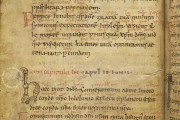The Durham Ritual is a compilation manuscript that preserves the earliest record of the Durham Rite, a version of the Christian liturgy that fuses the Roman Rite and the Gallican Rite. The core of the text, the collectar, was written in the early tenth century in southeast England. By the later tenth century, it was held by the exiled monastic community driven from Lindisfarne during their time at Chester-le-Street. During this period, Aldred the Glossator added additional texts and glossed the Latin collector in Old English.
As a functional book, decoration in the Durham Ritual is minimal. Most striking is the use of rubrication to visually separate glossed lines from the original Latin text. Enlarged initials are a source of playful decoration as their forms are diverse and lively. Additional zoomorphic initials appear on the earliest folios and a handful of marginal drawings occur in the collectar. However, the value of this manuscript lies in its rich textual and social history as a working manuscript within an important Christian community in pre-Conquest England.
A Treasure Trove of Language from Tenth-Century England
The Durham Ritual began as a Latin collectar brought north from Wessex. It, along with its later additions, likely remained as separate quires or booklets until around 1000 when it was bound together in Durham.
In addition to the liturgical and encyclopedic Latin texts, decorated with enlarged and rubricated initials, it preserves the hands of eleven separate scribes and a variety of pre-Carolingian century scripts and dialects. Aldred’s glosses are also a rare record of the Northumbrian dialect of Old English.
Aldred the Glossator’s Colophons — From Lindisfarne to Durham
Aldred is most well known from the colophon he added to the Lindisfarne Gospels when he wrote the Old English gloss to its Latin text. He also glossed an Old English translation for most of the Latin text in the Durham Ritual as well as scribing several additional pieces.
A shorter and less formal colophon than the one from the Lindisfarne Gospels appears on fol.89v in which he describes the circumstances of his work during a visit to Wessex with Bishop Ælfsige in 970. His colophons provide critical information about language, politics, and religion in the late tenth century.
Cuthbert’s Community at Chester-le-Street
Cuthbert, a seventh-century Anglo-Saxon saint, served as bishop of Lindisfarne priory at the end of his life and was buried there. When the community was driven from the Holy Isle, they transported his remains through Northumbria, settling for a time at Chester-le-Street. It was during the second half of this period, roughly 883 to 995, when Aldred added his glosses and when the majority of the additions were made.
The manuscript remained with the community when they settled in Durham and established the cathedral and monastery. It continued to be used in some fashion through the thirteenth century after which it was relegated to scrap use in the scriptorium and lost its first quire and several other folios. It was rediscovered in the eighteenth century as a priceless source for linguistic and liturgical history.
We have 1 facsimile edition of the manuscript "Durham Ritual": The Durham Ritual facsimile edition, published by Rosenkilde and Bagger, 1969
Request Info / Price






